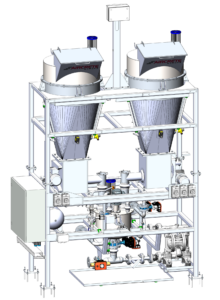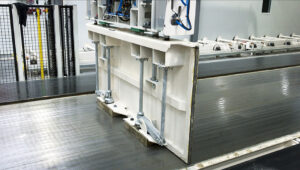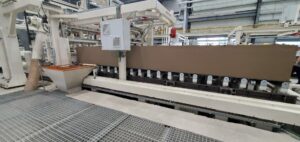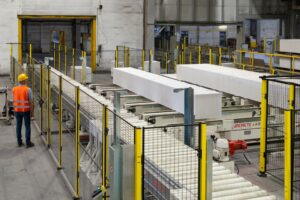In response to the dynamic landscape of the building materials industry, Aircrete is continuously exploring innovative solutions to cater to diverse market needs. Recognizing the demand for more adaptable and efficient manufacturing solutions, suppliers are targeting markets that may be deemed too small for conventional plants or where substantial distances necessitate a reimagined production approach. The article explores the potential benefits and considerations associated with the concept of the new Aircrete Compact Plant, addressing market adaptability, geographical optimization, flexibility, and cost efficiency. Moreover, this discussion sets the stage for an exciting development within the industry: Aircrete has recently signed a greenfield plant supply contract with Megaacrete in the United States, marking the initiation of the first compact plant project in the country. This ground-breaking venture signifies a significant leap forward in the application of compact plant strategies, showcasing their practicality and relevance in addressing the unique challenges of the industry’s diverse landscapes.
Compact plant concept
The evolution of the compact plant concept stems from the response to the nuanced challenges faced by the building materials industry. In markets where the demand may be perceived as insufficient to justify the establishment of a full-scale production facility, the compact plant emerges as a nimble and cost-effective solution. Simultaneously, in vast territories like the United States, where the sheer geographical expanse introduces logistical complexities and especially costs, the concept of a network of compact plants becomes promising. Beyond addressing the spatial challenges, this innovative approach accommodates markets that exhibit a unique blend of being both sizable and dispersed.
Additionally, the industry recognizes that some emerging market players, particularly those in the early stages of development, may operate with more constrained budgets and also do not have the need for the typical high volume Autoclaved Aerated Concrete (AAC) plants. The compact plant concept, with its modular and scalable design, aligns seamlessly with the financial considerations of these players, offering a viable avenue for entry and growth within the sector. As Aircrete navigates through the evolving dynamics of the industry, the compact plant concept is poised to play a transformative role, providing tailored solutions that bridge the gap between market demand, geographical constraints, and budget considerations.
It is true that a small-volume AAC factory is not a new phenomenon, however what is different with the Aircrete Compact Plant is the capability to produce thin AAC panels, which are defined as panels with a thickness of 100 mm or thinner, in a larger volume and in a sustainable way (implying acceptable waste levels within a standard AAC plant should not exceed 1% for blocks or 2-3% for panels).
What makes the Aircrete Compact Plant compact? The basis of the size reduction lies in the mould dimensions, which implies a net cake size of 3 meters long (or 10 ft) instead of standard 6 meters long cakes, 1.5 meters wide and 0.6 meters high. The mould dimensions change and, therefore, a significant part of the plant’s equipment must account for the change in dimensions. Reduced equipment dimensions result in a more compact layout that reduces the production hall area to approximately 2,500 m2 and the total required land plot to 25,000 – 30,000 m2. These reductions in size result in a significant reduction in the total budget requirements for the project, which can amount to up to 40% reduction for land and building. Of course, the equipment itself now needs to handle less weight and size of cakes, which also reduces the costs of the required machinery substantially (Fig. 1).
Fig. 1: The advantages of the Aircrete Compact Plant.
Production volume-wise, the compact plant allows for a significant lower starting capacity, starting at 216 m3 per day (which is approximately 65,000 m3 per year) and still making it a feasible investment case, whereas for a standard plant this threshold lies at 100,000 m³ or more per year. Although the factory is setup in a modular way and can be expanded both in product portfolio and production capacity (just like any Aircrete plant), a natural limitation is that the maximum capacity is limited to 540 m3 per day (which is approximately 160,000 m3 per year).
Another consideration of the Aircrete Compact Plant is the maximum panel length that can be produced, which is 10 ft (when imperial dimensions are required) or 3 meters (when metric dimensions are required). However, when targeting the walling market, which is the predominant target market for AAC panel products, typically 80-90 % (or even more) of it can be addressed with the 10ft or 3 m long panels (Fig. 2).
Fig. 3: The Aircrete low-speed mixer, with multiple paddles, ensures a better homogeneous mix.
Although the Aircrete Compact Plant has a different, more compact design than the standard Aircrete plant, the basis of the factory technology is unchanged. With the Aircrete Flat-Cake cutting line, clients are able to produce thin panels (100 mm or thinner) with Super Smooth product surface in a sustainable way.
A new product based on a proven concept
The design and technology of the Aircrete Compact Plant are based on the proven and innovative solutions employed in the larger Aircrete plants around the world, ensuring that high standards regarding plant availability, safety, and product quality are sustained.
The Aircrete Compact Plant is equipped with the Aircrete low-speed mixer with multiple paddles and an integrated flushing system. A major advantage of this type of mixer is a better homogenous mix to ensure an optimal mixing result for all possible density levels, regardless of the filling height of the mixer (which is of great importance for casting moulds with reduced volume (i.e. shorter cakes) (Fig. 3).
In line with the latest trends in the industry, the Aircrete Compact Plant is equipped with the latest generation Aluminium Dosing System, to meet the latest norms of safety, precision and efficiency and of dosing the aluminium paste in the production of high quality AAC (Fig. 4). The Aluminium Paste Dosing System is a standalone machine, with two storage bins and a unique dosing mechanism that allows for very high dosing precision of one or two different types of aluminium paste. For more details, please refer to the article “New Generation Aluminium Dosing System” in the 3rd edition of AAC Worldwide in 2023).
Fig. 4: The Aluminium Paste Dosing System allows for very high dosing precision of one or two different types of aluminium paste.
Similar to the normal Aircrete plant, the Aircrete Compact Plant operates with moulds that can be opened completely, which provides a big advantage when it comes to cleaning. As the mould doors fully open on all sides to a complete flat surface, the mould is easy to clean before it is oiled, thereby optimizing the oiling of the moulds which reduces the change of sticking and other quality issues in the production process (Fig. 5).
Fig. 5: The Aircrete moulds can be opened completely, which provides a big advantage when it comes to
cleaning, which in return prevents quality issues.
Needless to mention, when panels are included in the product portfolio of the Aircrete Compact Plant, the movable mould door is an option that should be included in the design. This is an absolute must-have for any AAC panel factory, to be able to make AAC panels in the most efficient way, without waste or undesired side products. An automated door manipulator picks the movable door out of the door carrier and places it in the desired position (Fig. 6). As the movable door is then locked in between the two side walls and together with the pusher pin magnets a leakproof locking of the movable door is ensured. Due to the innovative layout of the compact plant, only a single mould door manipulator is required, whereas in the larger plants tow will be required.
Fig. 6: The Aircrete Movable Mould Door in action: an automated door manipulator picks the movable door out of the door carrier and places it on the desired position.
Like every Aircrete factory, the Aircrete Compact Plant is based on the latest Aircrete’s Flat-Cake technology, where the cake is uniquely positioned horizontally (Fig. 7). This is a significant difference to the tilt-cake technology and the advantages become particularly clear during AAC panel production.
After the cross-cut, on the first section of the cutting line, takes place to cut the length of the panels, the cake ‘travels’ through the High Speed Cutting Frame (HSCF) where vertical double-wires oscillate at high speed to make a precise cut and create a “Super Smooth” surface. Since the products are vertically cut in a horizontal position, the openings between the products prevent sticking problems that require special separation systems and thereby allows to produce a very large product portfolio, including very thin (cladding) panels.
In Aircrete plants, the cake remains horizontal from casting, rising, cutting till unloading, and no separating nor green cake tilting machines are needed, which also means less handling and less risk of damage. In addition, since the frames on which the cakes are positioned circulate on roller tracks, there is no need for autoclave cars or autoclave bridges in the Aircrete Compact Plant.
Fig. 7: In all Aircrete plants, the cake remains horizontal from casting, rising, cutting till unloading,
and no separating nor green cake tilting machines are needed.
The Aircrete Compact Plant meets the latest standards with respect to energy and resources savings and efficiency. Water captured from the production process (including condensated steam) that is stored in a condensate basin is re-used (up to nearly 100 %) for the production process, thereby saving significant amounts of fresh (drinking) water for the production of AAC. In addition, through heat exchangers the heat from the hot condensate water is used again to heat other areas of the production process (e.g. rising area) or to preheat boiler feed water which leads to additional energy and water savings on top of this (as otherwise steam would be used for this). In addition, with Aircrete’s autoclave control system, through a fully-automated, steam piping system, steam is transferred between autoclaves to minimize energy consumption and optimize costs, which can save up to 25-30% of fresh steam requirements.
In the unloading area, the panel pack configuration system allows for fully automatic configuration of different pack sizes, resulting in maximized flexibility in product unloading (Fig. 9). After the panel pack configuration system, panel packs are placed automatically on inserted gluts (wooden beams) and straps are being placed, eventually with corner protection. This system significantly reduces the packaging costs and saves on resources.
Fig. 8: The distinct advantages of the Aircrete Flat-Cake cutting technology.
The plant control in the Aircrete Compact Plant is based on the Siemens S7-1500 control system with a new advanced SCADA visualization to substantially improve the human-machine-interfacing and ease of operation. Aircrete batching and dosing software, including advanced recipe control, and the latest autoclave control software, result in an optimized process and quality control of the plant. On top of the integrated plant control layer as described in the previous paragraph, it is possible to integrate a MES layer. This layer takes care of handling all production
orders, job and batch management, whether they are manually created or automatically inserted by an Enterprise Resource Planning (ERP) system through the Aircrete Application Programming Interface (API). For the next project in Kerrville, Texas, USA (see below), Aircrete will be developing a new innovative fully automated reinforcement mesh preparation and assembly solution that will reduce the headcount in this area of the factory by 6-8 people per shift compared to conventional systems. A detailed report on this innovation will follow in a later edition of AAC Worldwide after its implementation in the project.
Fig. 9: the Aircrete panel pack configurating system allows for fully automatic configuration of different pack sizes.
The Texas Project
The first Aircrete Compact plant will be set up in Kerrville, Texas, USA. This will also be the first factory to be set up under the Megaacrete brand (Fig. 10). The factory is envisaging to commence commercial production in 2026 and the product focus will be on producing 100 % panels of which almost all will be AAC thin panels ranging from 4 to 10 feet in length and available in 2, 3, and 4-inch thicknesses for the cladding, flooring, and fire wall applications. Salvador Garza, CEO of Megaacrete, commented “Our AAC thin panels deliver a unique advantage compared to standard framing construction in all its possibilities: firewall, cladding, and flooring. Megaacrete aims to become a standard solution in the US lightweight building industry.”
Fig. 10: The first Aircrete Compact plant, to be set up in Kerrville, Texas, USA, will be the first factory to be operating under the Megaacrete brand.
The Megaacrete brand
Megaacrete is a collaborative venture between Litecrete and Aercon. Litecrete, an AAC manufacturer based in Monterrey, Mexico, is owned by the Zam-brano family, renowned as one of the founding families of Cemex, one of the largest cement companies. Meanwhile, Aercon, owned by the Herb family, has established itself as a pioneer in AAC production since 2002, offering high-quality American-manufactured products distinguished by outstanding thermal and acoustic insulation properties as well as exceptional fire resistance. With 30 years of experience in
the manufacture of Autoclaved Aerated Concrete, Aercon and Litecrete, leading manufacturers of AAC in North America, unite forces to create Megaacrete, a new era in the AAC industry.
Ralf Beier, Managing Director of Aircrete Europe, commented “I have been active in the AAC industry for almost 3 decades and have witnessed how AAC was introduced in the USA back in the 90’s. As both the product portfolio and technology introduced back then were not really catered to the market, AAC has not grown since then in line with the huge potential it has in the USA. With Megaacrete, we have a new opportunity to accelerate AAC in the USA, particularly with thin cladding, fire wall and flooring panels. This time with a different, focused strategy, based on thorough preparations and the right AAC technology. I am con¡ dent that with the experienced AAC partners that stand behind Megaacrete, this first Megaacrete factory will be one of many across the USA and will be the start of a tremendous success story! As exclusive technology partner, Aircrete is excited to be part of the Megaacrete family.”
Conclusion
Although the first Aircrete Compact plant will set foot in Texas, USA, the potential for further expansion in North America under the Megaacrete brand is massive and it will be expected that many more Aircrete Compact Plants will follow soon across the region. In addition, the concept is not limited to the USA market only. With the introduction of the Aircrete Compact Plant, Aircrete has managed to provide a solution for smaller-capacity AAC production, based on proven technology and solutions to ensure the highest level of safety, quality and automation.











